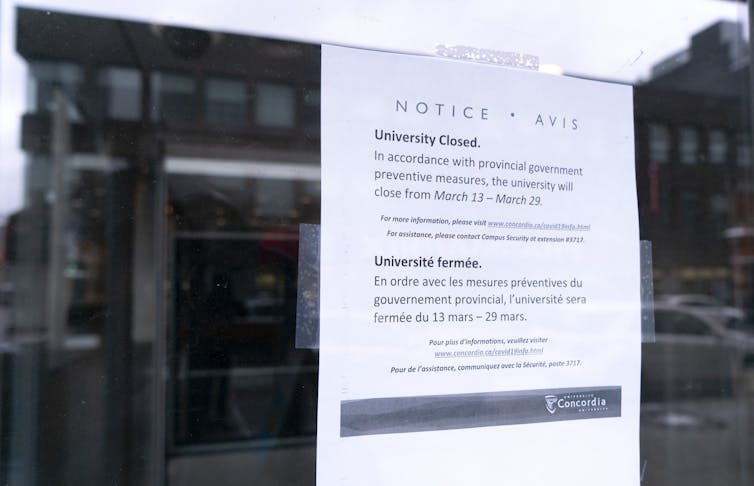How the COVID-19 pandemic may have changed university teaching and testing for good
The shift online demonstrated the convenience of distance learning and has convinced some learners, including workers and unemployed people, to study.

As of mid-March last year, governments worldwide imposed quarantines and social distancing practices as health measures in response to the spread of COVID-19. These restrictions disrupted millions of university students’ education worldwide and significantly altered university operations.
Universities changed their teaching, including a rapid switch to online learning. But what will the long-term effects be of universities’ new approaches?
Our analysis is a preliminary scan of various sources, including articles, academic papers, reviews, blogs, seminars, surveys and online discussion forums pertaining to universities in Canada. This research is an extension of the work the Centre on Governance is currently conducting with the Institut de la Francophonie pour la Gouvernance Universitaire. Some of the ideas presented here are taken up as a part of a series of webinars under the theme transforming the university in times of crisis.
During the pandemic, universities had to quickly co-ordinate with administrative staff, professors, students and technical teams to transfer courses online to complete their academic year. This required faculty and students to rapidly master the use of learning management systems (such as Moodle, Blackboard, Brightspace, Google Education and others) and distance learning communication software products (such as Zoom, Adobe Connect, Skype and Teams) to name a few.
Students and university staff had to make significant adjustments. Beyond using what to many were unfamiliar online media and teaching tools, they also had to adapt to new methods of engagement, classroom interaction, teaching practices and student-faculty communication.
These unprecedented circumstances sometimes led to unusual situations like in the case when students discovered, without notice, that some virtual lectures they viewed were being offered by a professor who passed away a year before the pandemic. This extraordinary example demonstrates the unstable and rapidly shifting context in which the transition to the virtual format has often materialized.

New formats of how students are evaluated have particularly challenged faculty and students. The move of assessments and final exams to a virtual form has arguably raised the most critical academic integrity issues among administrators, faculty and students.
On the one hand, faculty had minimal experience in preparing for online exams. The open-book format and the lack of student monitoring paved the way for more cheating than usual. On the other hand, students, especially those with limited access to the internet, feared that they would be at a disadvantage in the online assessments.
Read more: Online exam monitoring can invade privacy and erode trust at universities
Combining all these sources of stress has led to a detrimental impact on the mental health of students and academic staff. As a result, many universities have been quick to include adaptive measures. On the one hand, this situation will likely have a temporary impact on the value of degrees. On the other hand, this context may also open the door for faculty and institutions to rethink course assessments and academic integrity in the future.
In most cases, the transition has not been easy. Students have often expressed their preference for more conventional classroom learning practices. But the most important impact of virtual teaching was felt in the drop of international students travelling to Canadian universities.
The School of Public Policy at University of Calgary reported in February that a reduction in international student arrivals in Canada has meant 92,000 fewer students on campus for 2020 compared to 2019. This relative apprehension about online learning combined with travel restrictions can serve to explain why many international students decided to forgo the pursuit of studying in-person abroad.
Even though the changeover from in-person to online learning has been a challenge, universities have also found several benefits to this teaching method. The shift to online learning has demonstrated the versatility and adaptability of administrative staff, faculty and library administrators.
Besides, it has made universities aware of student access to personal computers in learning and the various systems for managing online learning in university education. The transfer to online learning has demonstrated the convenience of distance learning and has even convinced some students (including adults, workers, unemployed and disabled persons) to reintegrate into university study programs.
In the process, universities have realized that e-learning can contribute to the diversification of their student population by reducing students’ costs. Students who can learn at a distance effectively do not have to deal with the costs of commuting, housing and meal plans. Besides, online learning saves time for students who live off-campus by not having to travel.
Read more: After COVID-19, funding post-secondary students directly could create more accessible education
In the short term, it also favours students who previously might have postponed pursuing higher education due to the inconvenience of distance. In short, this mode of teaching allows universities to reflect on the diversity of their student populations and to take into account particular needs.
Beyond the educational issues, some see it as an opportunity to reduce operational costs. That puts additional pressure on universities to make their transition to distance learning a permanent reality, at least in part.
After this past year, universities will revise their contingency measures. By incorporating online and distance learning as crisis response measures, universities can normalize this alternative by anticipating future crises. It will also be necessary to maintain a critical approach to pressures from the private sector, as educational technology companies and other large technology firms advocate for an increased and permanent transition to online education.
In sum, COVID-19 has changed the world, and academia is no exception. It has profoundly changed the way people interact with each other, the way they work and the way they learn. Universities are now realizing that teaching practices will ultimately never completely return to the previous model.![]()
Eric Champagne, Professeur agrégé, École d’études politique, Directeur, Centre d’études en gouvernance / Associate professor, School of Political Studies, Director, Centre on Governance, L’Université d’Ottawa/University of Ottawa and Aracelly Denise Granja, Research Assistant, Centre of Governance, L’Université d’Ottawa/University of Ottawa
This article is republished from The Conversation under a Creative Commons license. Read the original article.


